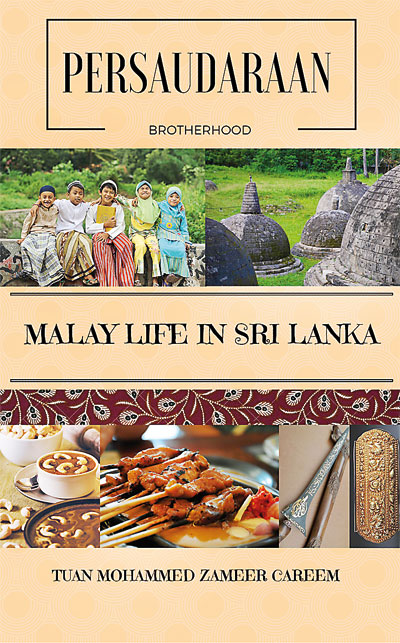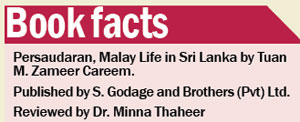Rich Malay pickings from the ‘salad bowl’ that is Sri Lanka
View(s): The Malay community of Sri Lanka is a picturesquely pleasing reminder of the island’s geography in the Indian Ocean. It is equidistant from the Straits of Malacca and the Straits of Hormuz. The Malays are originally from the Indonesian archipelago and are mostly Muslims. Their ubiquitous presence that dots the ethno-social fabric of the island remind us of the illuminating inquiry ‘what’s a rainbow with one colour? ‘Their weight and the impact of their achievements and contributions to society far outweigh their numbers.
The Malay community of Sri Lanka is a picturesquely pleasing reminder of the island’s geography in the Indian Ocean. It is equidistant from the Straits of Malacca and the Straits of Hormuz. The Malays are originally from the Indonesian archipelago and are mostly Muslims. Their ubiquitous presence that dots the ethno-social fabric of the island remind us of the illuminating inquiry ‘what’s a rainbow with one colour? ‘Their weight and the impact of their achievements and contributions to society far outweigh their numbers.
The Malays of Sri Lanka have a common origin and a culture that has largely survived the acculturation inevitable in adopted homelands. These attributes qualify them as a distinct ethnic minority in the ‘salad bowl’ that is modern Sri Lanka.
The Malays are the tangy olives, not many, that when encountered, give distinctly delightful relish to the salad. A young Malay medical student Tuan Zameer Careem has chosen to pick those ‘olives’ in the Lankan salad and offered them in the deliciously readable book ‘Persaudaran’. First, he has to be congratulated for his remarkable achievement reached parallel to his pursuit of higher studies in the frighteningly competitive stampede to enter Medical College. A feat that demonstrates Malay resilience! A review of his compendium of Malay lore in the island will not be complete unless we recognize his contribution to social anthropology of the country, made in that period of the most thrilling part of life- the years between adolescence and adulthood, devoting time to be a mature social historian.
Persaudaran is a significant addition to the literature of socio cultural and ethnic studies in Sri Lanka. The compilation of widely scattered, historically relevant, authentic material relating to the political, social, economic and cultural history of the Malays makes it an invaluable source for researchers and students of social sciences. One cannot help but regret that he did not receive the guidance of an experienced social historian for deeper sociological analysis of the rich material assembled. Young Careem proceeds with a fleeting survey of how the Malays arrived and how they set down their roots in the island of Sri Lanka after weeks of sailing with favourable winds from the Malay peninsula. The etymological and historical explanations the author gives to places with links to the Malay community are interesting and informative i.e Java Patnam (the etimology of Jaffna), Javaka –cheri meaning the Fort of Javakas (present day Chavakacheri).
The book is a narrative that asserts the multicultural mosaic that the Sri Lankan communities are comprised of. The fateful war waged by the pre-Islamic Buddhist Javanese King Chandrabunu who brought in foot soldiers to acquire possession of Lord Buddha’s tooth relic and his defeat are interwoven into Zameer’s beautifully flowing and compelling narrative.
The Dutch initiative of settling Malays too receives a general sweep owing to obvious space constraints in an already thick volume. The Dutch inclination to use their territory in Sri Lanka as a holding station for inconvenient or rebellious Malay nobility resisting them receives greater focus. The exiled Malay nobility, apparently retained their sense of ‘Noblesse oblige’ and assumed leadership roles within the local community. The Malays brought by the Dutch were hired soldiers but evidently not short of valour and bravery. The book deals with the rise of the Malay regiment introduced by the Dutch but used with far greater imagination by the British.
The book is an interesting commentary on the immergence of Malay mosques;Malay saints; Malay personalities; Malay culture, Malay costumes and cuisine.
The author Zameer Careem is a fourth year medical student. He has devoted much energy to researching the Malay community. He has commenced exploring the dim corridors of Malay history in Sri Lanka at the age of 18. He acknowledges the guidance of his mother and grandmother who have added lustre to his narrative. That indeed is natural. Such small ethno-cultural enclaves survive only in the hands of women who are the natural custodians of the intangible heritage of the tribe, clan and community.

How did he as a medical student find the time? His reply was, “this is my main source of distraction that I enjoy which takes me a way from the hard medical studies”. During vacations over the past few years, Zameer has been busy with his archival and data collation. The book is in one sense an eagle eye view of Malays’ lives and their rich cultural traditions. The book contains an interesting array of visuals, cultural snippets, narratives and notes. His grandmother has provided the recipes of Malay dishes, narrated Malay myths and elaborated on Malay marriage rituals.
The integrity of any research rests on its authenticity. It may not be the full story. But, by any standard ‘Persaudaran’ is an authentic account of the Malay brotherhood of Sri Lanka. Zameer Careem is fortunate to have had an authentic source-a Malay grandmother. Overall, capturing the socio-cultural life of Malays in one volume is a commendable effort by the young author.


